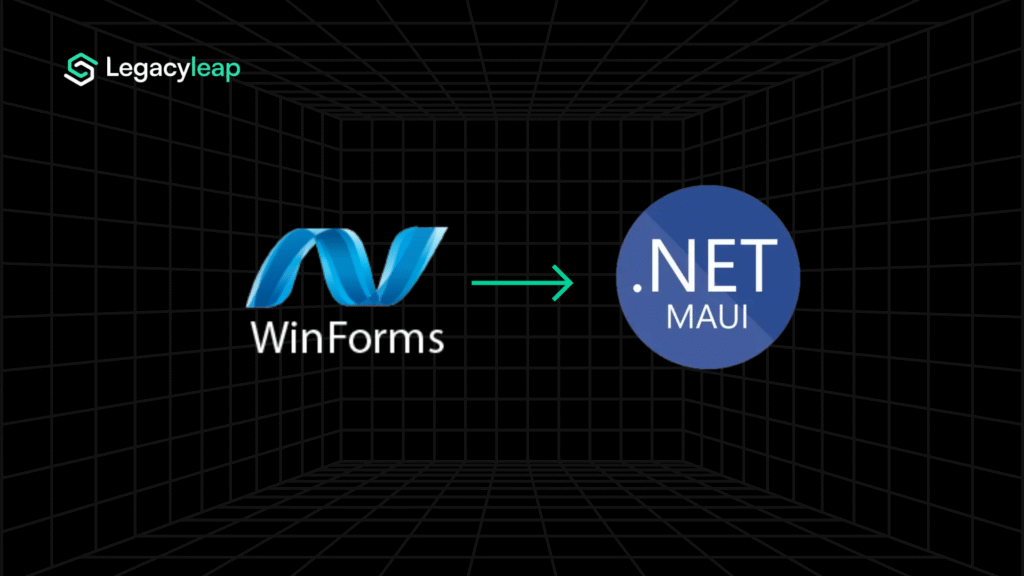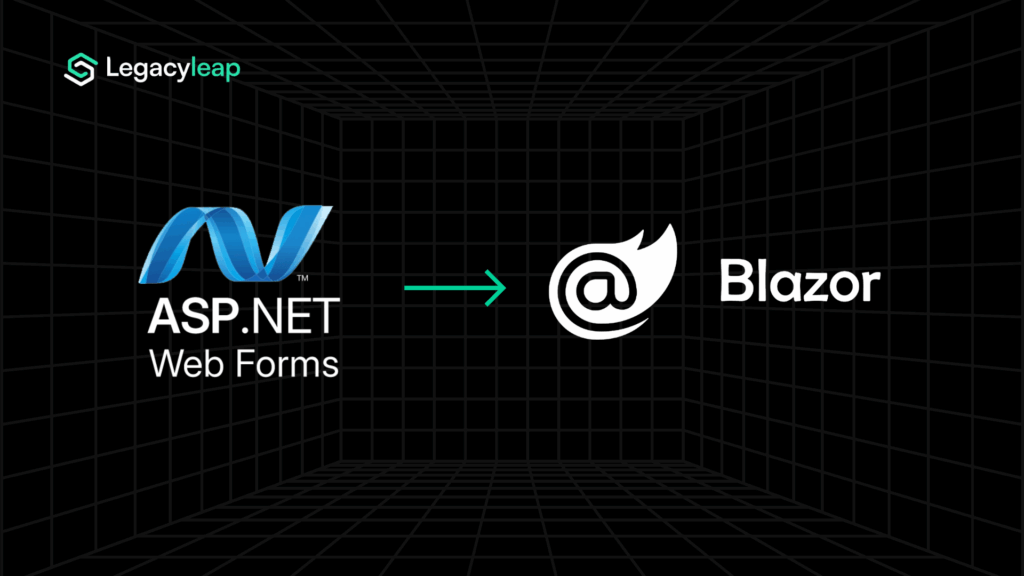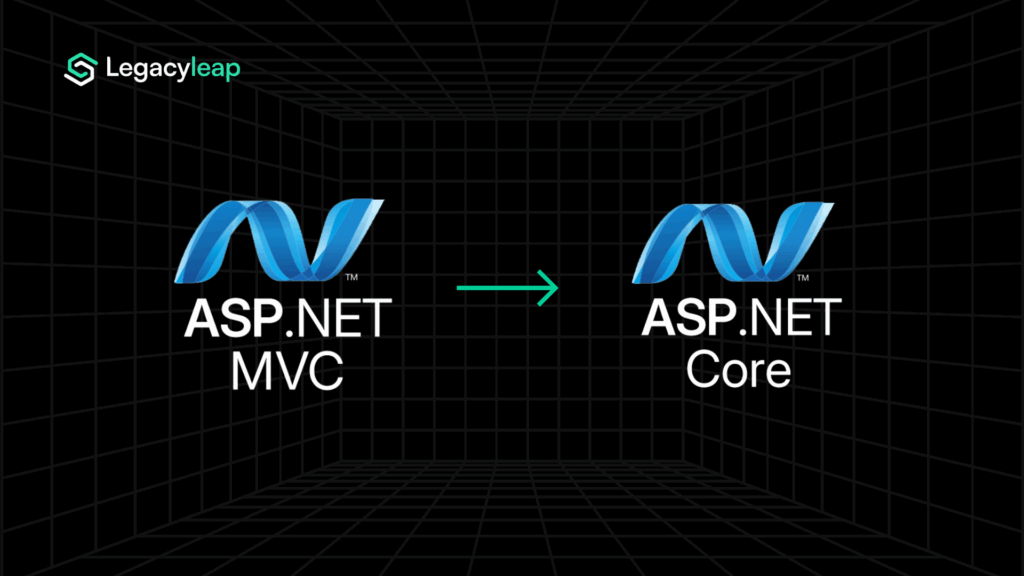Despite reaching its end-of-life in 2021, AngularJS remains deeply embedded in enterprise applications. Whether due to developer familiarity, high modernization costs, or the principle of not breaking what works, organizations have been reluctant to move away.
However, as security vulnerabilities and compatibility issues mount, the risks of maintaining outdated systems are becoming impossible to ignore.
With the world shifting toward an AI-first era, enterprises need to stay agile, scalable, and secure. Legacy AngularJS applications struggle to integrate with modern APIs, support cloud-native architectures, and enable AI-driven functionalities. This growing disconnect between old frameworks and new demands makes modernizing Angular JS to Angular necessary.
But modernization comes with its own set of challenges. Manually rewriting applications is costly, time-consuming, and prone to disruption. Organizations need an approach that accelerates modernization while minimizing risk.
Fortunately, we are in the AI era! When used right, Gen AI is one of the most versatile tools for accelerating application modernization projects by intelligently analyzing legacy code, automating refactoring, and optimizing dependencies. It can streamline modernization, reducing complexity and effort.
In this guide, we’ll explore why modernizing AngularJS to Angular is essential and dive deep into how Gen AI can accelerate and optimize this process like never before.
For engineering teams already managing AngularJS apps in production and looking to modernize with minimal risk and high ROI, this guide is for you!
Let’s dive in.
Why modernize from AngularJS to Angular?
Despite its legacy, moving from AngularJS to Angular is now essential because AngularJS no longer meets the demands of modern application development, security, and scalability. Its architecture, performance limitations, and lack of official support make modernization necessary for enterprises seeking scalability, security, and long-term maintainability.
Key Differences Between AngularJS and Angular That Impact Modernization
These differences are often the deciding factor for organizations choosing to convert AngularJS to Angular.
| Feature | AngularJS (1.x) | Angular (2+ and above) |
| Architecture | MVC (Model-View-Controller) | Component-Based Architecture |
| Language | JavaScript (ES5) | TypeScript (ES6+) |
| Data Binding | Two-way binding | Optimized two-way binding |
| Mobile Support | Limited | Fully optimized for mobile |
| Performance | Slower (digest cycle-based) | Faster with enhanced change detection |
| Dependency Injection | Limited and less flexible | Powerful and hierarchical |
| Directives | Complex syntax | Simplified and improved |
| Routing | Third-party libraries required | Built-in powerful routing module |
| Testing | Less testable | Enhanced testability via DI |
| Component-Based | Partial support | Full support with reusable components |
| CLI Support | No official CLI | Angular CLI for automation |
| Modular Development | Not modular | Fully modular with lazy loading |
| SEO Support | Limited | Improved SEO with Angular Universal (SSR) |
| Community Support | Legacy support only | Active support with regular updates |
Why Angular Is the Better Choice for Modern Applications
When you convert AngularJS to Angular, you solve the biggest problems that AngularJS comes with: performance, security, and scalability.
- Performance boost: Faster applications with optimized change detection and efficient dependency injection.
- Stronger security: Compliance with OWASP security standards to mitigate vulnerabilities.
- Developer efficiency: TypeScript’s static typing prevents runtime errors, and Angular CLI automates workflows.
- Future-ready architecture: Component-based design for modular, maintainable, and scalable applications.
- Mobile & SEO optimization: Built-in mobile-first support and server-side rendering (SSR) for search visibility.
For businesses still on AngularJS, the cost of delay grows daily. Upgrading ensures security, longevity, and adaptability in an AI-first, cloud-native world.
What Are the Traditional Approaches to Modernizing AngularJS to Angular?
Modernizing from AngularJS to Angular typically follows one of two strategies, each with its own advantages and challenges:
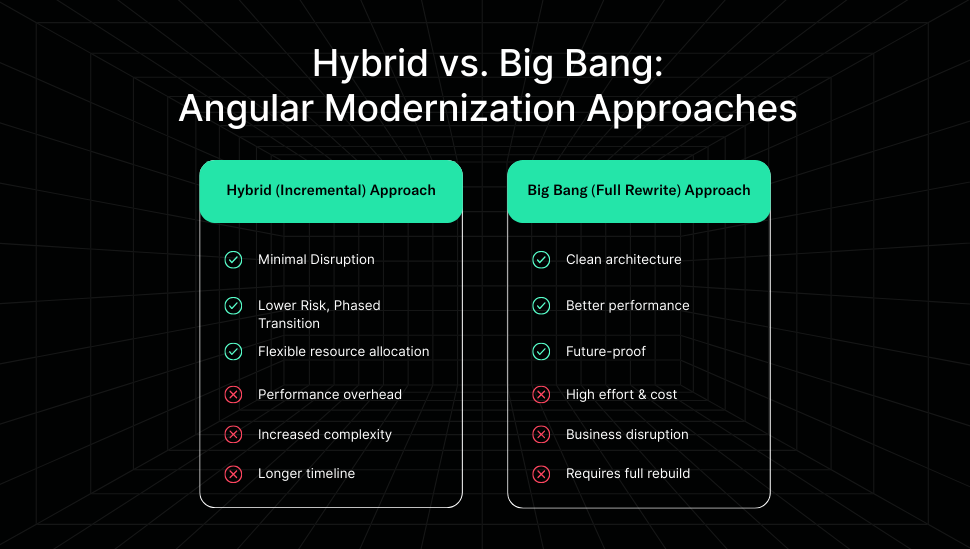
1. Hybrid (Incremental) Approach
This method leverages ngUpgrade, allowing AngularJS and Angular to coexist within the same application. Developers modernize components and services gradually while keeping the application functional.
Pros:
- Minimal disruption: Enables a phased transition without affecting users.
- Easier risk management: Critical features remain stable while sections are modernized.
- Flexible resource allocation: Teams can modernize incrementally without halting other development efforts.
Cons:
- Performance overhead: Running both frameworks simultaneously can slow down the app.
- Code complexity: Maintaining two frameworks increases technical debt.
- Longer modernization timeline: Full transition can take months or years.
2. Big Bang (Full Rewrite) Approach
In this method, developers rebuild the entire Angular application from the ground up, replacing AngularJS completely.
Pros:
- Cleaner architecture: Eliminates legacy dependencies, leading to better maintainability.
- Performance gains: Fully optimized for modern browsers and devices.
- Future-proofing: Ensures long-term compatibility with Angular updates.
Cons:
- High initial effort: Requires a full redesign, testing, and validation before launch.
- Business disruption: The application remains in development until the new version is ready.
- Resource-intensive: Demands dedicated teams and significant development effort.
Regardless of the approach chosen, the traditional modernization process follows a structured series of steps from initial assessment to final deployment. Below is an overview of the key stages involved in a typical AngularJS to Angular modernization.
Hybrid vs. Big Bang: AngularJS to Angular Migration Approaches
| Factor | Hybrid (Incremental) | Big Bang (Full Rewrite) |
| Disruption | Minimal. App remains live while new Angular modules are introduced gradually | High. Requires freeze or full cutover once the Angular rewrite is complete |
| Speed to Start | Fast. Teams can begin replacing high-priority features immediately | Slower to start due to upfront architecture and re-scaffolding work |
| Code Complexity | Dual-framework complexity (AngularJS + Angular coexist), especially in routing and state | Cleaner, unified codebase—no legacy compatibility overhead |
| Risk Level | Lower. Rolls out features incrementally with functional parity checks | Higher. Issues may surface only at the end if testing isn’t exhaustive |
| Performance Impact | Temporary trade-offs from bootstrapping both AngularJS and Angular runtimes | Fully optimized performance for Angular from the start |
| Cost Profile | Spread over time; easier to stage resourcing | Higher upfront cost but potentially faster overall if done right |
| Best Suited For | Large, business-critical apps needing continuity during migration | Smaller apps or those undergoing broader architectural overhaul |
Checklist for a Successful AngularJS to Angular Migration with Gen AI
1. Analyze the existing codebase – Use Gen AI tools like TSLint and Codelyzer to document architecture, identify dependencies, and estimate ROI.
2. Choose the right migration strategy – Decide between a hybrid (ngUpgrade) approach or a full rewrite based on complexity, disruption tolerance, and timelines.
3. Set up the Angular environment – Install Angular CLI, configure dependencies, and ensure compatibility with existing project structures.
4. Modernize components and services – Convert AngularJS controllers/services to Angular components using AI-driven dependency injection and RxJS for reactive programming.
5. Upgrade routing – Replace $routeProvider with Angular Router and enable lazy loading for performance optimization.
6. Update forms and data binding – Migrate from ng-model to Angular’s reactive forms, ensuring unidirectional data flow.
7. Transition HTTP requests – Replace $http with Angular’s HttpClient for better API handling, caching, and error management.
8. Replace outdated dependencies – Identify and remove unsupported third-party libraries; ensure compatibility with Angular modules.
9. Implement automated testing – Use Gen AI to generate unit, integration, and end-to-end test cases with tools like Jest, Chai, and Mocha.
10. Deploy with monitoring – Integrate AI-generated deployment artifacts into CI/CD pipelines, and set up post-launch monitoring to detect and resolve issues early.
Overview of the traditional modernization process
Common Pitfalls and Challenges in Modernizing from AngularJS to Angular
| Step | Key Actions | Considerations |
| 1. Planning & Assessment | Analyze the existing codebase and define modernization goals. | Evaluate app complexity, business impact, and resources. |
| 2. Choose a modernization Strategy | Select Hybrid (ngUpgrade) or Full Rewrite. | Balance resource constraints, disruption, and timeline. |
| 3. Setup Angular Environment | Install Angular CLI, configure dependencies. | Ensure compatibility with existing project structure. |
| 4. Hybrid modernization (ngUpgrade) | Run AngularJS and Angular in parallel. | Suitable for phased modernization with minimal downtime. |
| 5. Component & Service modernization | Convert components/services, adopt Angular DI patterns. | Move from $scope to RxJS-based reactive programming. |
| 6. Routing modernization | Replace $routeProvider with Angular Router. | Implement lazy loading for better performance. |
| 7. Data Binding & Forms | modernize from ng-model to Angular’s form handling. | Ensure unidirectional data flow for efficiency. |
| 8. HTTP Requests | Transition from $http to Angular HttpClient. | Improve API call efficiency and error handling. |
| 9. Dependency Management | Replace outdated third-party libraries. | Ensure compatibility with Angular modules. |
| 10. Testing & Validation | Use Jasmine/Karma for unit tests, Protractor/Cypress for E2E testing. | Maintain feature parity and stability. |
| 11. Finalizing modernization | Remove AngularJS code, optimize performance, and deploy. | Monitor for issues and fine-tune post-modernization. |
Common Pitfalls and Challenges in Modernizing from AngularJS to Angular
- Compatibility gaps: AngularJS and Angular follow fundamentally different architectures, making direct interoperability challenging. Legacy AngularJS code relies heavily on $scope and controllers, while Angular is component-driven and reactive. Bridging these differences often leads to inconsistencies, requiring additional refactoring efforts.
- Performance bottlenecks: Hybrid modernizations using ngUpgrade allow AngularJS and Angular to run side by side, but this approach can introduce inefficiencies. Increased memory consumption, duplicate event bindings, and unnecessary digest cycles can slow down performance, especially in large-scale applications. Optimizing this transition requires careful dependency management and phased rollouts.
- Testing challenges: Ensuring feature parity between AngularJS and Angular requires rigorous testing at every stage. Differences in testing frameworks such as transitioning from Protractor to Cypress or updating unit tests from Jasmine/Karma to Jest can lead to gaps in coverage. Maintaining backward compatibility while verifying new functionality adds an extra layer of complexity.
- Skill gaps: Modernizing to Angular requires developers to adapt to new paradigms, including TypeScript for static typing, RxJS for reactive programming, and a modular component-driven structure. Teams unfamiliar with these concepts face a steep learning curve, which can slow down modernization efforts and introduce bugs if best practices are not followed.
How Gen AI Accelerates AngularJS to Angular Migration
Moving from AngularJS to Angular is a complex process that involves understanding legacy code, refactoring outdated patterns, and ensuring a seamless transition, all while minimizing disruption.
Traditionally, this requires extensive manual effort, but Gen AI transforms the modernization process by automating key modernization tasks, reducing errors, and accelerating timelines.
Here’s how Gen AI plays a huge role in accelerating Angular modernization.
- Automated business logic extraction: One of the biggest challenges in modernization is deciphering the original application’s logic. Gen AI accelerates this by scanning the existing AngularJS codebase, extracting business rules, and mapping dependencies, eliminating the need for tedious manual analysis.
- Intelligent code refactoring: Instead of a direct translation, Gen AI refactors code based on best practices for Angular. It identifies outdated patterns, optimizes performance, and converts JavaScript-based logic into structured, maintainable TypeScript code.
- Automated test case generation: A risk-free modernization demands rigorous testing. Gen AI generates test cases across unit, integration, and functional levels, ensuring that the modernized application maintains feature parity with the legacy system while improving overall stability.
- Compatibility issue detection & auto-fix: Modernizing to Angular introduces compatibility challenges, from third-party dependencies to API changes. Gen AI detects potential issues in real time and applies automated fixes, preventing common roadblocks before they impact development.
- Continuous optimization & performance enhancements: Gen AI doesn’t just modernize code; it enhances it. During the assessment phase, it identifies inefficient code structures, recommends optimizations, and ensures that the final Angular application is scalable, secure, and high-performing.
Gen AI has proven to be an invaluable tool in reducing modernization timelines, minimizing riks, and ensuring a future-proof Angular application without the inefficiencies of traditional modernization methods.
And to show you how it’s done right, let’s look at how Legacyleap approaches Angular modernization with Gen AI!
Legacyleap’s Gen AI Angular Modernization Framework
Modernizing an AngularJS application requires a structured approach to ensure efficiency, maintainability, and minimal disruption. Legacyleap’s framework leverages Gen AI-driven automation combined with expert oversight to accelerate and optimize every stage of modernization.
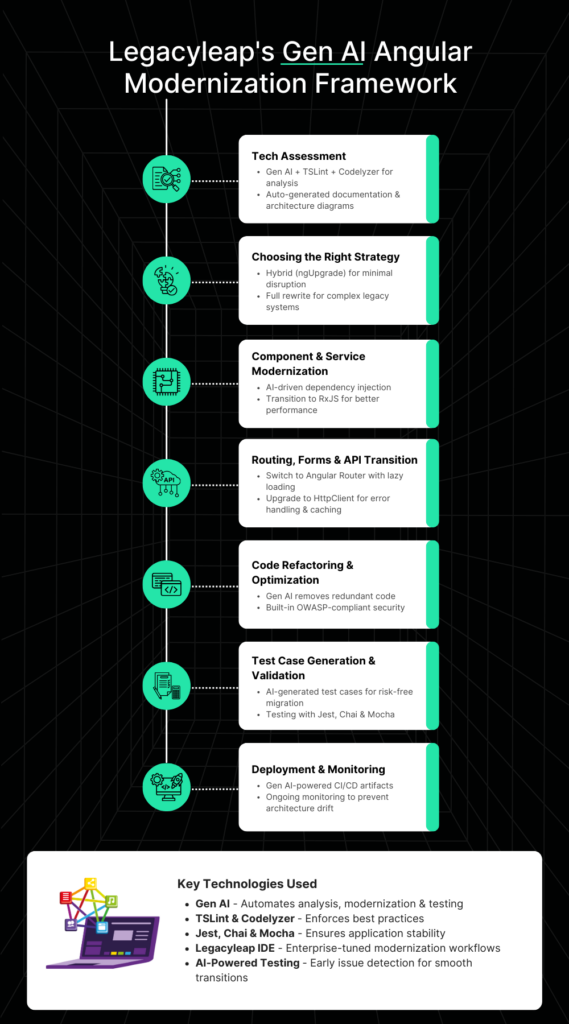
1. Tech assessment
- Utilize Gen AI, TSLint, and Codelyzer to analyze the existing codebase and estimate the ROI of modernizing.
- Automatically generate detailed documentation, architectural diagrams, and dependency graphs to guide the transition strategy.
2. Choosing the right modernization strategy
- Gradual hybrid modernization using ngUpgrade allows AngularJS and Angular to run side by side, minimizing disruption for large applications.
- Full rewrite for legacy applications that are too outdated or complex, with Gen AI optimizing the new architecture from the ground up.
3. Component & service modernization
- AI-driven dependency injection patterns streamline component and service conversion.
- Shift from $scope-based data flow to RxJS-driven reactive programming for improved performance and scalability.
4. Routing, forms & API transition
- Replace $routeProvider with Angular Router, enabling lazy loading for faster load times.
- Upgrade from $http to Angular’s HttpClient, ensuring improved error handling, request caching, and observability.
5. Code refactoring & optimization
- Gen AI detects and eliminates redundant, inefficient, or legacy code structures, ensuring maintainability.
- Security enhancements with OWASP-compliant coding standards are built into the modernization process.
6. Test case generation & validation
- AI-driven automation generates unit, integration, and functional test cases, ensuring complete feature parity.
- Utilize Jest, Chai, and Mocha for comprehensive testing across all application layers.
7. Deployment & monitoring
- Gen AI-generated deployment artifacts ensure seamless CI/CD integration.
- Post-modernization monitoring prevents architecture drift and optimizes performance in the live environment.
Want a $0 assessment of your AngularJS app? We’ll modernize one codebase for free—so you can see firsthand how Gen AI transforms the process.
Tools and Technologies for AngularJS to Angular Migration
A successful Angular modernization process demands the right combination of automation, analysis, and validation tools. Legacyleap integrates Gen AI-driven automation with industry-standard frameworks to enhance efficiency and accuracy.
Here are some of the key technologies in our modernization framework:
- Gen AI Integration: Automates code analysis, modernization, and test case generation, reducing manual effort.
- TSLint & Codelyzer: Static analysis tools that identify deprecated patterns and enforce best practices.
- Jest, Chai, and Mocha: Provide unit, integration, and functional testing to ensure application stability.
- Legacyleap’s Proprietary IDE: Custom-built with enterprise-specific enhancements for seamless modernization workflows.
- Continuous Testing Frameworks: AI-powered automated testing that identifies modernization issues early, ensuring smooth transitions.
Role of human expertise
While Gen AI accelerates modernization, human expertise remains essential for strategic oversight and fine-tuning. Legacyleap’s team ensures a seamless transition by balancing automation with deep technical insight.
Here’s where human expertise makes the difference:
Critical decision-making in strategy:
- Choosing between hybrid modernization and a full rewrite based on business goals and technical constraints.
- Defining modularization strategies to enhance scalability in the new Angular architecture.
Fine-tuning & validation in complex scenarios:
- Handling non-standard legacy code where AI-based automation requires manual intervention.
- Ensuring data integrity, security compliance, and performance optimizations post-modernization.
- Reviewing and optimizing automated test cases to align with business logic and real-world usage.
By integrating AI-driven automation with expert oversight, Legacyleap delivers a risk-free, scalable, and future-ready Angular modernization experience.
Benefits of Gen AI in Angular modernization
Traditional modernization methods are time-intensive, error-prone, and heavily dependent on manual effort. Legacyleap’s Gen AI-driven modernization platform eliminates these inefficiencies by introducing automation, security compliance, and continuous validation, ensuring a faster, more reliable transition to Angular.
1. Efficiency gains
Gen AI accelerates Angular modernization by automating code analysis, modernization, and validation, reducing the time and effort required.
- 40% faster modernization compared to traditional approaches based on internal benchmarks.
- AI-generated test cases, deployment artifacts, and documentation streamline the process.
- Ensures high-quality code that aligns with enterprise-grade standards.
2. Risk mitigation
Seamless modernization requires continuous monitoring and validation to prevent performance issues or disruptions.
- Automated compatibility checks during hybrid modernization ensure a smooth transition.
- Continuous testing with AI-generated unit, integration, and functional test cases minimizes business downtime.
- Detailed code analysis with visual diagrams and code graphs helps developers catch and fix issues early.
3. Scalability & security
Security and maintainability are critical in any modernization effort. Legacyleap’s platform ensures future-proof applications with built-in security compliance and post-modernization monitoring.
- OWASP-compliant code refactoring enhances security from the ground up.
- Hybrid modernization with continuous testing ensures zero downtime during the transition.
- Post-modernization monitoring prevents architectural drift and maintains long-term scalability.
By leveraging Legacyleap’s AI-powered framework, businesses can modernize AngularJS applications faster, with higher reliability, reduced risk, and future-ready architecture.
Why most Angular modernization tools fall short — and how we solved that
Modernization platforms often use Gen AI as an add-on, assisting with isolated tasks like code conversion or documentation. This makes it helpful but not central to the process.
Legacyleap takes a fundamentally different approach. It is the only purpose-built platform where Gen AI drives every phase of Angular modernization, ensuring a seamless transition with zero business disruption.
Beyond automation, three core aspects set Legacyleap apart for Angular modernization:
1. Agentic AI for Angular-specific tasks
Instead of applying a generic model, Legacyleap’s agentic AI architecture selects the best-fit models for each stage, whether it’s analyzing TypeScript structures, migrating AngularJS controllers to components, or optimizing modern Angular architecture with RxJS.
2. Enterprise-tuned modernization for Angular frameworks
The platform learns from enterprise tech guidelines, developer inputs, and compiler feedback, ensuring that the modernization process follows best practices for Angular architecture, dependency injection, and modularization while adhering to security standards like OWASP compliance.
3. Continuous AI-powered monitoring for future Angular versions
Legacyleap’s AI-driven monitoring agents track changes in the Angular ecosystem post-modernization and proactively flag compatibility risks, allowing enterprises to stay ahead of deprecations and framework updates.
With Gen AI deeply embedded in every step—from assessment to post-modernization monitoring—Legacyleap accelerates Angular modernization while maintaining code quality, security, and long-term adaptability.
The future of Angular modernization is Gen AI-driven
Looking at application modernization as moving from old to new is one thing. But the reality today is that app modernization is about positioning enterprises for the future.
As frameworks like Angular continue to evolve, traditional modernization approaches will struggle to keep pace with the rapid advancements in architecture, security, and performance expectations. And with AI being integrated into every business for every function, this is a no-brainer now!
With that said, Gen AI is your best friend. From understanding legacy business logic to automated code transformation and continuous post-modernization optimization, AI-driven modernization ensures that enterprises don’t just modernize, but future-proof their applications for long-term success.
For organizations navigating the Angular modernization journey, the choice is clear:
Manual modernization introduces risk and inefficiency. Generic automation lacks contextual intelligence.
Legacyleap, built with Gen AI at its core, delivers a seamless, secure, and scalable modernization path, ensuring business continuity while accelerating innovation.
Ready to make Angular modernization a competitive advantage? Let’s talk. Reach out to us today to discuss a tailored strategy for your business.
FAQs
Timelines vary based on app complexity, but Gen AI significantly compresses the process. While traditional migrations can take 6–12 months, Legacyleap’s Gen AI-powered modernization can cut that by up to 50%, especially when handling UI logic mapping, component generation, and parity validation at scale.
Not always. You can choose between a Hybrid (incremental) approach using ngUpgrade, or a Big Bang (full rewrite) approach. Gen AI supports both, helping teams prioritize components, maintain parity, and reduce disruption regardless of the strategy you choose. Although as a general recommendation, we always suggest the incremental approach.
Not fully, but it automates the most time-consuming and error-prone parts by design. This includes controller-to-component conversion, RxJS-based service generation, dead code removal, and UI test case creation. Human oversight is still essential for business logic validation, UI/UX fidelity, and final deployment decisions.
Gen AI reduces the likelihood of security regressions by auto-detecting outdated libraries, vulnerable patterns (like $http), and deprecated APIs. It also generates Angular-compliant code that aligns with modern security practices, like strict input/output bindings, HttpClient, and scoped modules, minimizing attack surfaces.
Loss of UI/UX fidelity if the migration is purely syntactic. Incomplete state/routing logic if modularization is mishandled. Coexistence issues in hybrid setups (dual bootstraps, shared services). Regression bugs from manual rewrites or missing test coverage.
Gen AI helps mitigate these risks by preserving logic, enforcing functional parity, and auto-generating validation tests.



